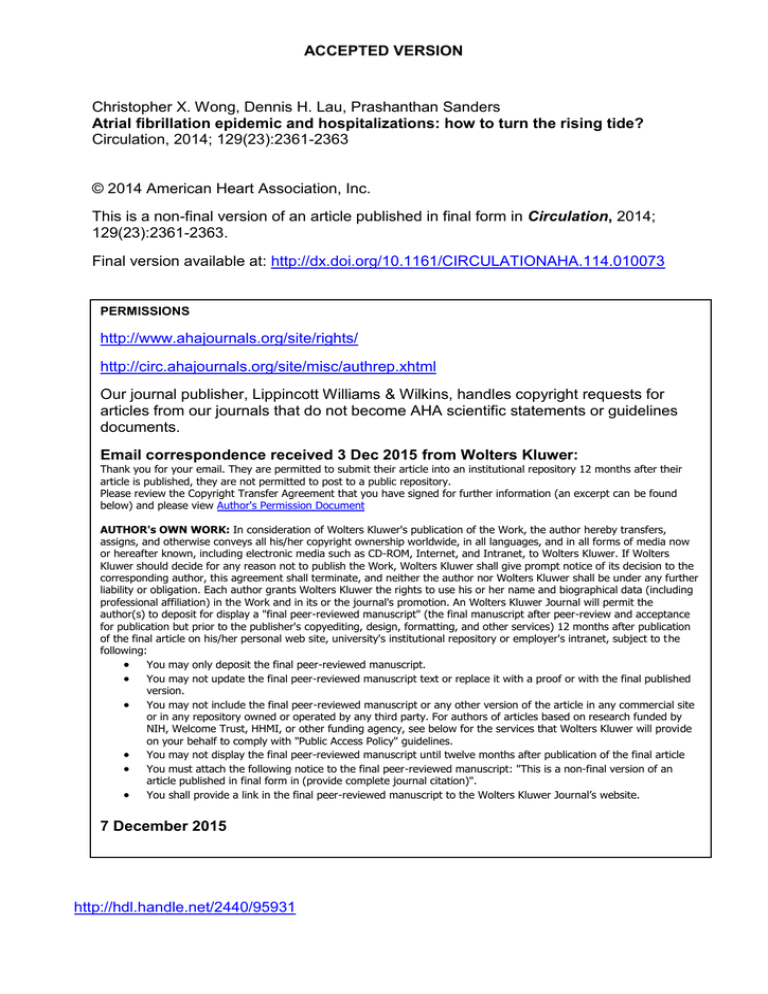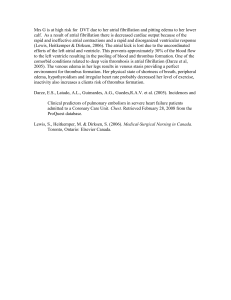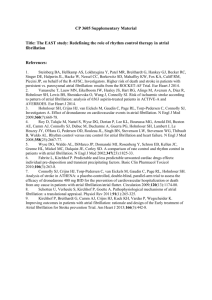ACCEPTED VERSION Christopher X. Wong, Dennis H. Lau
advertisement

ACCEPTED VERSION Christopher X. Wong, Dennis H. Lau, Prashanthan Sanders Atrial fibrillation epidemic and hospitalizations: how to turn the rising tide? Circulation, 2014; 129(23):2361-2363 © 2014 American Heart Association, Inc. This is a non-final version of an article published in final form in Circulation, 2014; 129(23):2361-2363. Final version available at: http://dx.doi.org/10.1161/CIRCULATIONAHA.114.010073 PERMISSIONS http://www.ahajournals.org/site/rights/ http://circ.ahajournals.org/site/misc/authrep.xhtml Our journal publisher, Lippincott Williams & Wilkins, handles copyright requests for articles from our journals that do not become AHA scientific statements or guidelines documents. Email correspondence received 3 Dec 2015 from Wolters Kluwer: Thank you for your email. They are permitted to submit their article into an institutional repository 12 months after their article is published, they are not permitted to post to a public repository. Please review the Copyright Transfer Agreement that you have signed for further information (an excerpt can be found below) and please view Author's Permission Document AUTHOR's OWN WORK: In consideration of Wolters Kluwer's publication of the Work, the author hereby transfers, assigns, and otherwise conveys all his/her copyright ownership worldwide, in all languages, and in all forms of media now or hereafter known, including electronic media such as CD-ROM, Internet, and Intranet, to Wolters Kluwer. If Wolters Kluwer should decide for any reason not to publish the Work, Wolters Kluwer shall give prompt notice of its decision to the corresponding author, this agreement shall terminate, and neither the author nor Wolters Kluwer shall be under any further liability or obligation. Each author grants Wolters Kluwer the rights to use his or her name and biographical data (including professional affiliation) in the Work and in its or the journal's promotion. An Wolters Kluwer Journal will permit the author(s) to deposit for display a "final peer-reviewed manuscript" (the final manuscript after peer-review and acceptance for publication but prior to the publisher's copyediting, design, formatting, and other services) 12 months after publication of the final article on his/her personal web site, university's institutional repository or employer's intranet, subject to the following: You may only deposit the final peer-reviewed manuscript. You may not update the final peer-reviewed manuscript text or replace it with a proof or with the final published version. You may not include the final peer-reviewed manuscript or any other version of the article in any commercial site or in any repository owned or operated by any third party. For authors of articles based on research funded by NIH, Welcome Trust, HHMI, or other funding agency, see below for the services that Wolters Kluwer will provide on your behalf to comply with "Public Access Policy" guidelines. You may not display the final peer-reviewed manuscript until twelve months after publication of the final article You must attach the following notice to the final peer-reviewed manuscript: "This is a non-final version of an article published in final form in (provide complete journal citation)". You shall provide a link in the final peer-reviewed manuscript to the Wolters Kluwer Journal’s website. 7 December 2015 http://hdl.handle.net/2440/95931 CIRCULATIONAHA XXX Atrial Fibrillation Epidemic & Hospitalizations: How to Turn the Rising Tide? Christopher X. Wong, MBBS; Dennis H. Lau, MBBS, PhD; Prashanthan Sanders, MBBS, PhD. From: Centre for Heart Rhythm Disorders (CHRD), South Australian Health and Medical Research Institute (SAHMRI), University of Adelaide and the Royal Adelaide Hospital, Adelaide, Australia. Address for Correspondence: Prashanthan Sanders, MBBS, PhD Department of Cardiology, Royal Adelaide Hospital, Adelaide, SA 5000, AUSTRALIA T: +61 8 8222 2723; F: +61 8 8222 2722; E: prash.sanders@adelaide.edu.au Total Manuscript Word Count: 2242 Subject Codes: [5], [8], [100] Page 1 of 9 CIRCULATIONAHA XXX Numerous countries worldwide are facing the major challenge of rising healthcare expenditure, a concern driven particularly by advancing medical treatments and ageing population structures. In the United States (US) over the last 50 years, increasing national healthcare expenditure has consistently outpaced growth in real gross domestic product (GDP) per capita, exceeding every other country to peak at 18% of GDP in 2012.1 Given that hospitals are the largest contributor to each dollar spent on healthcare, the characterization of hospitalization trends is a logical first step in identifying possible opportunities to intervene and slow the rising demands on healthcare systems. It is in this context that Patel and colleagues describe contemporary trends of hospitalizations for atrial fibrillation (AF) in the current issue of Circulation.2 An increasing number of recent studies have highlighted the emergence of AF as a growing epidemic.3, 4 While the morbidity and mortality associated with this most common arrhythmia has been increasingly well characterized, few studies have comprehensively described the effect of rising AF rates on hospital utilization on a national scale. Using data from the Nationwide Inpatient Sample, Patel and colleagues therefore characterized the trend of hospitalization rates for AF in the US from 2000 to 2010. They found an overall 23% growth in AF hospitalizations, importantly noting that the increase was particularly prominent in elderly patients. More than two third of the patients were over 65 years of age, and those over 80 years of age had an exponential increase in hospitalization rates (9361 per million in 2001 to 11045 per million in 2010). Furthermore, despite a static mean length of stay and declining in-hospital mortality associated with AF hospitalizations, inflation-adjusted costs from these hospitalizations Page 2 of 9 CIRCULATIONAHA XXX rose from $6,410 in 2001 to $8,439 in 2010. As a result, the annual national cost of AF hospitalizations rose from 2.15 billion dollars in 2001 to 3.46 billion dollars in 2010. Similar to US healthcare expenditure patterns in general, most of the annual healthcare costs associated with AF has been linked to inpatient care.5 The increasing hospitalization trends seen in this contemporary analysis thus confirm that the economic and public health burden of hospitalizations as a component of total AF healthcare costs continues to grow. It also is in agreement with other data suggesting that the rate of increase in AF may be overtaking other common conditions, such as myocardial infarction and heart failure, as the dominant reason for cardiovascular hospitalizations. 6 Furthermore, the present analysis did not include emergency department presentations and AF complicating hospitalizations where a different primary diagnosis was listed; these figures may therefore be an underestimate of both the total scale and cost of AFrelated hospital utilization. The increasing global burden of AF has been recently likened to a rising tide in this journal.7 The pertinent question, therefore, is how to turn this tide, if it is indeed a tide? While tides recede, data to date suggest that the burden of AF shows no sign of abating and a more appropriate metaphor may therefore be “rising sea levels”. It is in this regard that subtleties from the present and prior reports provide important insights and implications. These provide multiple possible reasons for the “rising sea levels”. The increasing incidence of AF with age is an obvious contributor given the ageing population; however, the confirmation that the age-specific rate of AF hospitalizations is also increasing is noteworthy.8 While the reasons for this age-specific increase is not clear, comorbid conditions, symptom severity and atrial remodeling have amongst other Page 3 of 9 CIRCULATIONAHA XXX factors been identified as predictors of AF hospitalizations; it is possible that worsening risk factor profiles independent of the ageing population are driving these predictors.9 Some have suggested the emergence of electrophysiology procedures may be a significant contributor but this has not been confirmed in other reports.8, 10 Regardless of the reasons, however, the increase in age-specific hospitalization rates has significant implications for healthcare planning given the multiplicative effects of continually ageing population structures.11 Patel and colleagues also describe how the prevalence of numerous comorbidities increased over the study period; these included hypertension, diabetes mellitus, chronic obstructive pulmonary disease, obesity and renal failure. While other major AF risk factors such as ischemic heart disease and obstructive sleep apnea were not reported, it was interesting to note that the rates of heart failure and valvular disease did not increase over the study period. While heart failure was associated with greater in-patient mortality, these data are nevertheless consistent with the trend that other AF risk factors are increasingly more prevalent at a population level than heart failure and valvular disease and therefore relevant to the current AF epidemic. It is most likely that the increasing prevalence of these risk factors is fuelling the underlying atrial substrates that predispose to the development of AF. Public health interventions to reduce the burden of AF on both patients and healthcare systems should thus be centered on the prevention and management of risk factors as this approach is likely to have the greatest population impact. Given age is not modifiable, closer and more aggressive attention is warranted towards the treatable, predisposing risk factors mentioned above that are increasingly prevalent in our ageing society. Supporting the likely potential for Page 4 of 9 CIRCULATIONAHA XXX this strategy to be effective is the fact that Patel and colleagues found that hospitals in the Southern region where the ‘stroke belt’ and excess comorbidities are found constituted the greatest percentage of AF hospitalizations. The importance of aggressive risk factor modification in the management of AF is highlighted by the profound impact on AF symptom burden and thus possibly healthcare utilization.12 Indeed, a focus on risk factor management may assist in the primary prevention of AF. Likewise, it is important to identify unrecognized and under treated risk factors that may contribute to poorer rhythm control in AF patients and resulting in greater healthcare utilization.13 Patel and colleagues also describe how increasing dispositions to another facility contribute to overall costs; this is particularly significant for those patients suffering consequent stroke in whom one-quarter required transfer to a long-term institution. It has been consistently recognized that a significant percentage of patients with AF do not receive guideline-recommended antithrombotic therapy; this reflects not only underanticoagulation in those at high risk of ischemic stroke, but also, over-anticoagulation in those at low risk.14 Others have similarly highlighted that suboptimal management of antithrombotic medication in those with AF may predict hospitalizations.9 Better antithrombotic management of patients with established AF is therefore is an area worth targeting to reduce healthcare utilization from ischemic strokes or bleeding complications. The recent emergence of novel anticoagulants also promises to costeffectively reduce healthcare utilization though this requires further confirmatory study.15 Finally, it may be possible to reduce hospitalizations by implementing processes that shift management from an inpatient to outpatient setting. Optimizing rate and Page 5 of 9 CIRCULATIONAHA XXX rhythm management strategies for those with established AF, including continual advancements in and application of ablation techniques, may assist in this regard.16 Systems approaches to streamline the complex management of AF are also highly effective. One US hospital has previously described how implementation of AF practice guidelines at their institution significantly reduced hospitalization rates without increase in adverse events, preventing avoidable inpatient management and leading to significant economic savings.17 Specialized clinics staffed with experienced teams, comprehensive management programs and electronic support systems are also promising approaches to reduce hospitalizations and possibly cardiovascular mortality.18 In conclusion, Patel and colleagues have highlighted that the AF epidemic is having a continual and significant impact on hospital utilization in the US. Their report contributes to the growing body of evidence that AF represents a major public health concern worldwide and cements the need for us to do better – in preventing AF, in treating individuals with established AF and in implementing better system approaches to AF management – lest our hospitals and wider healthcare systems be engulfed by the “rising sea levels” of the AF epidemic. Page 6 of 9 CIRCULATIONAHA XXX SOURCES OF FUNDING Partly funded by the South Australian Cardiovascular Research Development Grant from the National Heart Foundation of Australia. Dr Wong is supported by a Rhodes Scholarship and a Postgraduate Scholarship from the National Health and Medical Research Council of Australia (NHMRC). Dr Lau is supported by a Postdoctoral Fellowship from the NHMRC. Dr Sanders is supported by a Practitioner Fellowship from the NHMRC and the National Heart Foundation of Australia. DISCLOSURES Dr Sanders reports having served on the advisory board of Biosense-Webster, Medtronic, St Jude Medical, Sanofi-Aventis and Merck, Sharpe and Dohme. Dr Sanders reports having received lecture and/or consulting fees from Biosense-Webster, Medtronic, St Jude Medical, Boston Scientific, Merck, Sharpe and Dohme, Biotronik and Sanofi-Aventis. Dr Sanders reports having received research funding from Medtronic, St Jude Medical, Boston Scientific, Biotronik and Sorin.. Page 7 of 9 CIRCULATIONAHA XXX REFERENCES 1. 2. 3. 4. 5. 6. 7. 8. 9. 10. 11. 12. World Health Organization. Global Health Expenditure Database. http://apps.who.int/nha/database/DataExplorerRegime.aspx. Accessed March 15, 2014. Patel NJ, Deshmukh A, Pant S, Singh V, Patel N, Arora S, Shah N, Chothani A, Savani GT, Mehta K, Parikh V, Rathod A, Badheka AO, Lafferty J, Kowalski M, Mehta JL, Mitrani RD, Viles-Gonzalez JF, Paydak H. Contemporary Trends of Hospitalization for Atrial Fibrillation in the United States, 2000 through 2010: Implications for Healthcare Planning. Circulation 2014;(in press) Chugh SS, Havmoeller R, Narayanan K, Singh D, Rienstra M, Benjamin EJ, Gillum RF, Kim YH, McAnulty JH, Jr., Zheng ZJ, Forouzanfar MH, Naghavi M, Mensah GA, Ezzati M, Murray CJ. Worldwide epidemiology of atrial fibrillation: a global burden of disease 2010 study. Circulation 2014;129:837-847 Ball J, Carrington MJ, McMurray JJ, Stewart S. Atrial fibrillation: profile and burden of an evolving epidemic in the 21st century. Int J Cardiol 2013;167:18071824 Coyne KS, Paramore C, Grandy S, Mercader M, Reynolds M, Zimetbaum P. Assessing the direct costs of treating nonvalvular atrial fibrillation in the United States. Value Health 2006;9:348-356 Wong CX, Brooks AG, Leong DP, Roberts-Thomson KC, Sanders P. The Increasing Burden of Atrial Fibrillation Compared to Heart Failure and Myocardial Infarction: A 15-Year Study of All Hospitalizations in Australia. Arch Intern Med 2012;172:739-741 Alonso A, Bengtson LG. A rising tide: the global epidemic of atrial fibrillation. Circulation 2014;129:829-830 Wong CX, Brooks AG, Lau DH, Leong DP, Sun MT, Sullivan T, RobertsThomson KC, Sanders P. Factors Associated with the Epidemic of Atrial Fibrillation. Am J Cardiol 2012;110:1496-1499 Steinberg BA, Holmes DN, Ezekowitz MD, Fonarow GC, Kowey PR, Mahaffey KW, Naccarelli G, Reiffel J, Chang P, Peterson ED, Piccini JP. Rate versus rhythm control for management of atrial fibrillation in clinical practice: results from the Outcomes Registry for Better Informed Treatment of Atrial Fibrillation (ORBIT-AF) registry. Am Heart J 2013;165:622-629 Kumar S, Walters TE, Halloran K, Morton JB, Hepworth G, Wong CX, Kistler PM, Sanders P, Kalman JM. Ten-year trends in the use of catheter ablation for treatment of atrial fibrillation vs. the use of coronary intervention for the treatment of ischaemic heart disease in Australia. Europace 2013;15:1702-1709 Miyasaka Y, Barnes ME, Gersh BJ, Cha SS, Bailey KR, Abhayaratna WP, Seward JB, Tsang TS. Secular Trends in Incidence of Atrial Fibrillation in Olmsted County, Minnesota, 1980 to 2000, and Implications on the Projections for Future Prevalence. Circulation 2006;114:119-125 Abed HS, Wittert GA, Leong DP, Shirazi MG, Bahrami B, Middeldorp ME, Lorimer MF, Lau DH, Antic NA, Brooks AG, Abhayaratna WP, Kalman JM, Sanders P. Effect of weight reduction and cardiometabolic risk factor Page 8 of 9 CIRCULATIONAHA XXX 13. 14. 15. 16. 17. 18. management on symptom burden and severity in patients with atrial fibrillation: a randomized clinical trial. JAMA 2013;310:2050-2060 Lau DH, Middeldorp ME, Brooks AG, Ganesan AN, Roberts-Thomson KC, Stiles MK, Leong DP, Abed HS, Lim HS, Wong CX, Willoughby SR, Young GD, Kalman JM, Abhayaratna WP, Sanders P. Aortic stiffness in lone atrial fibrillation: a novel risk factor for arrhythmia recurrence. PloS one 2013;8:e76776 Kakkar AK, Mueller I, Bassand JP, Fitzmaurice DA, Goldhaber SZ, Goto S, Haas S, Hacke W, Lip GY, Mantovani LG, Turpie AG, van Eickels M, Misselwitz F, Rushton-Smith S, Kayani G, Wilkinson P, Verheugt FW, Investigators GR. Risk profiles and antithrombotic treatment of patients newly diagnosed with atrial fibrillation at risk of stroke: perspectives from the international, observational, prospective GARFIELD registry. PloS one 2013;8:e63479 Limone BL, Baker WL, Kluger J, Coleman CI. Novel anticoagulants for stroke prevention in atrial fibrillation: a systematic review of cost-effectiveness models. PloS one 2013;8:e62183 Alboni P, Botto GL, Baldi N, Luzi M, Russo V, Gianfranchi L, Marchi P, Calzolari M, Solano A, Baroffio R, Gaggioli G. Outpatient treatment of recent-onset atrial fibrillation with the "pill-in-the-pocket" approach. N Engl J Med 2004;351:23842391 Zimetbaum P, Reynolds MR, Ho KK, Gaziano T, McDonald MJ, McClennen S, Berezin R, Josephson ME, Cohen DJ. Impact of a practice guideline for patients with atrial fibrillation on medical resource utilization and costs. Am J Cardiol 2003;92:677-681 Hendriks JM, de Wit R, Crijns HJ, Vrijhoef HJ, Prins MH, Pisters R, Pison LA, Blaauw Y, Tieleman RG. Nurse-led care vs. usual care for patients with atrial fibrillation: results of a randomized trial of integrated chronic care vs. routine clinical care in ambulatory patients with atrial fibrillation. Eur Heart J 2012;33:2692-2699 Page 9 of 9





![Anti-ABCC9 antibody [S323A31] - C-terminal ab174631](http://s2.studylib.net/store/data/012696516_1-ac50781de55479848678303901c47ff1-300x300.png)
